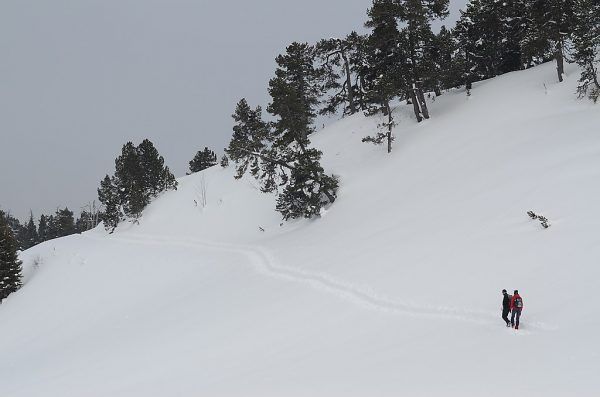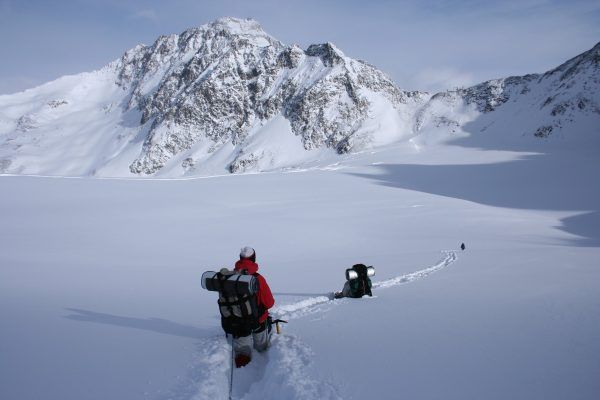One of the most important items on your winter hiking gear checklist is a good jacket. They say that there’s no such thing as bad weather but bad clothing. Keeping your upper body warm and dry is the key factor in making your hike more enjoyable and preventing conditions like hypothermia. However, choosing the right jacket can be a difficult task with so many different options and varieties available.
This guide will help you understand all the essential criteria that you need to consider when choosing a winter jacket, as well as, the best ones on the market for men and women.
The main criteria for choosing a winter jacket

Depending on what hike you decide to undertake, there are plenty of things that you need to consider when choosing the right winter jacket. You need to think about the kinds of conditions and weather that you will likely face as this will impact what kind of jacket you need. The different materials, features and weather resistance that you can find in various jackets will depend on your needs, preferences and expected trail conditions.
Layering
Layering is one of the best ways to keep yourself warm and dry with each layer having specific purposes. Your base layer is for wicking away sweat and keeping you feeling dry. While your middle and outer layers are for insulation and weather resistance.
Jackets are designed to be the middle or outer layer. This means that when you’re choosing your jacket you should make sure that there is plenty of room for you to add layers underneath it. There is also a key difference between mid-layers, which are usually soft shell, insulating jackets, and outer layers, which are generally hard shell, waterproof jackets. This difference will impact the materials, weight and added features that the jacket has.
Material
The type of material you need to consider will depend on what purpose the jacket needs to have. For example, a waterproof jacket will be made from different materials than a warm, insulating down jacket.
Synthetic materials: Materials like nylon and polyester with added spandex have added stretch and are more fitted. These synthetic materials can have features like quick drying, sweat wicking and added warmth.
Merino wool: Some soft-shell jackets may also be made from this natural material that has moisture wicking, insulating and odourless properties.
Synthetic insulation: Synthetic down provides warm insulation, however, their warmth to weight ratio is not as good as feathered down.
Feathered down: Duck or goose down jackets have superior heat retention and warmth, however, they’re not practical in wet weather and take a long time to dry.
Gore-tex or durable water resistant coating: Outer shells or hard shell jackets usually have some sort of waterproof membrane or water resistant coating for keeping the elements at bay.
Weight
The weight of the jacket may not be your first concern, but it’s something that you should consider especially if you need something that will not restrict your movement or be too bulky to pack into your daypack.
Typically, fleece and lightweight synthetic materials will be the lightest options. Down jackets can also be lightweight and can even be packed down into their own sacks for easy portability. In comparison, thick, hard-shell waterproof jackets can be quite heavy.
Breathability
Breathability is one of the most important qualities of a winter hiking jacket. You still sweat in cold weather and it’s important to make sure that your clothes will allow you to regulate your body temperature while you’re moving. It’s when you get wet and cold that winter hiking can become uncomfortable and dangerous to your health, so breathable clothing is extremely important.
Mid-layer jackets made from synthetic materials like nylon or natural fibres like merino wool will be more breathable than hard shell or waterproof options. However, this is where layering your clothing becomes important. Layering will allow you to take off your outer layers to a more breathable mid-layer jacket when you get too warm.
Insulation
Heat retention and insulation becomes important when the weather is extremely cold or when you stop moving. It can be difficult to keep yourself warm when you stop for a break in winter or the temperature drops below freezing. This is when insulating layers become important.
Some mid-layers made from synthetic materials like fleece or natural fibres like merino wool offer some form of insulating effect when layered. However, for optimal insulation in cold conditions most people prefer either a feathered down or synthetic down jacket.
These puffy jackets have incredible heat retention properties that can keep you warm even in sub-zero weather. As mentioned above, goose or duck down has the best warmth to weight ratio, meaning they are incredibly lightweight for the amount of heat they can retain.
Durability
If you’re heading into the backcountry and likely going to be hiking over rough terrain, then durability might be an important factor for you to consider. Durability simply means that your jacket can be worn over and over again without failing.
Although price sometimes impacts the durability of a product, it can also come down to the materials used. You can look for ripstop fabrics which are woven materials like nylon which resist tearing. Tough outer shell membranes are also durable materials, as long as you stick with a reputable brand.
Weather resistance
Weather resistance is an extremely important winter hiking criteria, especially if you expect to encounter snow, rain and wind on your hike. However, hiking jackets come in a variety of different levels of weather resistance.
Terms like water-resistant, waterproof and water repellent are all technically different. Fully waterproof membranes such as Gore-Tex are the best options for outer shell jackets that will keep you completely dry in a downpour. These membranes completely stop water from penetrating into the fabric and are also windproof. Other options are usually synthetic materials with a durable water resistance (DWR) coating applied on top. This will repel rain and water from the jacket, but over time this coating can wear down.
Extra features
The criteria for extra features comes down to your own personal preference and practicality.
Length
A slightly longer jacket will help protect you from the elements more than a shorter jacket. Some people opt for a jacket that extends past their waist which can add more warmth but can also restrict your movement more than a standard jacket.
Pockets
Pockets are important for hiking because they allow you to carry essentials that you want to have easy access to. Most jackets will at least have pockets for your hands, with some even offering insulated hand warmer pockets that are fleece lined. Some jackets also have internal pockets for small things or items that you want to ensure stay warm and dry.
Hoods
Whether you opt for a jacket with a hood or not really comes down to your personal preference and style. If you’re someone who likes to use a hood for warmth, then it can be a good feature. However, some people find hoods irritating and restrictive and prefer to keep their head warm with a wool hat or something similar.
How price can influence your choice
Prices of winter jackets can vary wildly. This generally depends on the quality and materials used but it can also come down to things like brand and reputation.
Materials such as merino wool, goose or duck down and waterproof Gore-Tex are usually more expensive than other synthetic blends. This is perhaps the biggest factor when it comes to price. However, in terms of superior warmth and waterproof qualities, they can be worth the splurge.
For example, when it comes to waterproof outer shell jackets, it’s best not to try and save too much because you will undoubtedly be left with lower quality that can leave you damp and cold.
The best winter jacket reviews
Winter hiking jackets for women

Best winter hiking jacket overall
Outdoor Research Transcendent Down Hoodie
This women’s down jacket has been a long-time favourite for hikers and outdoor enthusiasts. It’s an all-round fantastic winter jacket for all your cold-weather hikes. It’s made from tough materials and ethically sourced feathered down which makes it extremely warm and durable. The added features of extra pockets and a padded hood are all welcome additions. It’s surprisingly lightweight despite its warmth and it can be stuffed into its own sack for easy storage. There are really no cons for this jacket at all.
Specs:
- Fabric: 100% recycled ripstop polyester shell and down insulation
- Hood: Yes
- Pockets: Zippered hand pockets, external chest pocket and internal media pocket
- Weather resistance: Water and wind resistant
- Insulation: Goose down
Features:
- Water and wind resistant outer shell
- Left-hand pocket doubles as stuff sack
- Elastic drawcord hem
- Low-Pro Binding Elastic Cuffs
- Available in five colours
Best budget winter hiking jacket
Columbia Women’s Heavenly Hooded Jacket
For under $150, this hooded winter hiking jacket is a great choice. It ticks many of the boxes that you need from a good jacket with water-resistant features, insulating internal lining, zippered pockets and a hood. The cheaper price tag means that it’s made from synthetic down rather than feathered, which means it’s not as warm as other options on this list. It’s certainly not up to freezing conditions, but for your average winter hike and with added layers, this jacket is a good budget alternative.
Specs:
- Fabric: Synthetic polyester down and fleece lining
- Hood: Yes
- Pockets: Zippered hand pockets and internal security pocket
- Weather resistance: Water-resistant shell
- Insulation: Synthetic down with thermal reflective lining
Features:
- Omni-Heat thermal reflective lining
- Water-resistant outer shell for dry warmth
- Comfort cuffs with thumb holes
- Seven choices of stylish colours
Best winter jacket for -10 and below
Patagonia Fitz Roy Down Hoody
For your coldest adventures, this hooded down jacket should be your go-to. Patagonia has been making exceptional quality gear for years and their goose down fill is sustainably sourced and manufactured. The jacket is perfectly designed as an insulating mid-layer, with handwarmer pockets, heat locking hood and collar and a slightly longer drop-tail to keep you warm in the coldest places. It also has a durable water repellent coating in case you get caught in rain, but the feathered down would take a long time to dry in very wet conditions.
Specs:
- Fabric: 100% nylon outer shell with feathered down insulation
- Hood: Yes
- Pockets: Zippered hand pockets and two internal security pockets
- Weather resistance: Durable water repellent external coating
- Insulation: Goose down
Features:
- Lightweight and durable materials
- Fully baffled construction to prevent down migration
- Two hand warmer pockets with zippers
- Dual adjust drop-tail hem to lock in heat
Best winter jacket for -10 and above
Arc’teryx Cerium LT Hoody Women’s
This jacket is a great warm mid-layer for cold, icy conditions. The design of this jacket is all about trapping heat inside with high quality goose down insulation. It’s also got women’s bodies in mind for versatility and freedom of movement while hiking. It’s a pricey option but the exceptional quality of this jacket will mean you can get plenty of use out of it right through winter for many years to come.
Specs:
- Fabric: 100% nylon outer shell with feathered down insulation
- Hood: Yes
- Pockets: Zippered hand pockets and internal security pocket
- Weather resistance: Durable water repellent external coating
- Insulation: Goose down
Features:
- Lightweight, technical and minimalist down insulation
- Durable nylon outer shell for prolonged exposure to weather
- Efficient natural insulation for excellent warmth to weight ratio
Winter hiking jackets for men

Best winter hiking jacket overall
Arc’teryx Atom LT Hoody
This popular jacket from Arc’teryx is one of the best all-round winter jackets for hiking. It works perfectly as an insulating mid-layer with good warmth, breathability and comfort. It can also work as an outer layer with a durable water-resistant coating on the outer shell. Despite the insulation being from synthetic rather than feathered down, it means that the jacket is more ideal for wet weather as it will dry quicker than other down options. For complete warmth in freezing conditions, you should pair this jacket with some good base layers.
Specs:
- Fabric: 100% nylon outer shell, fleece-lined interior with synthetic insulation
- Hood: Yes
- Pockets: Zippered hand pockets and internal security pocket
- Weather resistance: Durable water-resistant external fabric
- Insulation: Synthetic
Features:
- Adjustable hood that is also insulated and low profile
- The latest generation of Coreloft Compact Insulation retains heat even when wet
- Light, soft and water-resistant fabric for ventilation
Best budget winter hiking jacket
REI Co-op 650 Down 2.0
For the cheap price you can’t go wrong with this jacket from REI. This impressive winter jacket is just under $100, making it a bargain for anyone looking for budget gear. It ticks many of the criteria with exceptional warmth, lightweight fabric, breathability and a water resistant coating. However, the cheaper price tag means that it doesn’t have added features like a hood or extra pockets. Still, you won’t find anything better for the price.
Specs:
- Fabric: 100% recycled nylon outer shell with feathered down insulation
- Hood: No
- Pockets: Zippered hand pockets
- Weather resistance: Durable water repellent external coating
- Insulation: Feathered down
Features:
- Responsible materials with recycled nylon and responsibly sourced and certified down
- 650-fill power down is lightweight with an exceptional warmth to weight ratio
- Highly compressible and packs into left pocket
Best winter jacket for -10 and below
Feathered Friends Khumbu Parker
This jacket is the best on the market when it comes to fierce cold and expedition-type adventures. The goose down and waterproof jacket is built for the coldest environments that is guaranteed to keep you warm and toasty. There are plenty of added features too with extra pockets, a fitted hood and high collar, as well as a storage pouch for when it’s not in use. The only downside is that it’s quite heavy at 950g and it’s expensive, however, if you’re heading into well below zero conditions or on high altitude expeditions then this jacket will be perfect.
Specs:
- Fabric: 100% nylon outer shell with goose down insulation
- Hood: Yes
- Pockets: Zippered hand pockets, two internal security pockets and one external chest pocket
- Weather resistance: Waterproof Pertex Shield outer shell
- Insulation: Goose down
Features:
- Made with traceable and ethical goose down in Seattle, USA
- Lofty and toasty 900+ goose down insulation
- Dual zipper system with insulated draft tube to retain body heat
Best winter jacket for -10 and above
Rab Neutrino Pro
This jacket from Rab is a highly rated lightweight jacket that is perfect for most cold-weather adventures. The beauty of this jacket is that it can work as both an insulating mid-layer, as well as, a waterproof outer layer. There’s not much the jacket can’t be used for in winter, except for the extreme cold above 4000m or similar. It’s a relatively expensive purchase but the durability and high quality of this jacket makes it a good investment.
Specs:
- Fabric: 100% nylon outer shell with feathered down insulation
- Hood: Yes
- Pockets: Zippered hand pockets and internal security pocket
- Weather resistance: Waterproof Pertex Quantum outer shell
- Insulation: Goose down
Features:
- Lightweight and packable with its own stuff sack
- 800 fill power of ethically sourced down locks in warmth
- A two-way front zip with synthetic insulated baffle to keep heat inside
Conclusion
There are so many options when it comes to choosing a winter hiking jacket. From down to synthetic and numerous weather-resistant varieties, it’s difficult to know what you need for cold weather backpacking. This article has outlined all the best jackets available and how to choose the right one for you.









